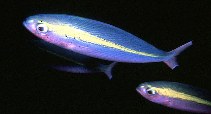| Family: |
Caesionidae (Fusiliers), subfamily: Caesioninae |
| Max. size: |
23 cm TL (male/unsexed) |
| Environment: |
reef-associated; marine; depth range 0 - 50 m, non-migratory |
| Distribution: |
Indian Ocean: Chagos Archipelago to Christmas and Cocos-Keeling islands. Western Central Pacific: Papua New Guinea, Philippines (Ref. 43437, 53416, 57038, 59110). Reports from the Comoros in western Indian Ocean (Ref. 4517) is being confirmed. |
| Diagnosis: |
Dorsal spines (total): 10-10; Dorsal soft rays (total): 14-16; Anal spines: 3-3; Anal soft rays: 12-13. Body bluish or reddish dorsally, lighter ventrally. 4-5 cheek scales; 23-30 predorsal scales; scaled dorsal and anal fins; confluent Supra-temporal band of scales at dorsal midline. Upper peduncular scale rows 12-14; lower peduncular scale rows usually 16-17 (15-17). Post maxillary processes 2; posterior end of maxilla tapered. A small flat process on either side of ventrolateral surface of basioccipital, projection not ventrally far from ventral rim of condyle (Ref. 1723). Caudal fin lobes with dark tips. Head length 3.1-3.7 in SL; body depth 4.1-5.3 in SL (Ref. 90102). |
| Biology: |
Inhabits coastal, lagoon, and seaward areas around coral reefs (Ref. 90102). Feeds on zooplankton in midwater aggregations. Oviparous, with numerous, small pelagic eggs (Ref. 402). Maximum length observed in the field estimated at about 20-25 cm TL (Ref. 74965). |
| IUCN Red List Status: |
Least Concern (LC); Date assessed: 09 June 2015 Ref. (130435)
|
| Threat to humans: |
harmless |
Source and more info: www.fishbase.org. For personal, classroom, and other internal use only. Not for publication.

